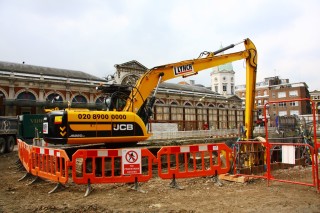Lynch Plant has supplied a long-reach JCB JS220 for excavation work at Farringdon Station. The Crossrail station being built here is split into two worksites - the Eastern Ticket Hall (ETH) and the Western Ticket Hall (WTH), both surrounded by residential and commercial properties and typically congested London streets. The JS220 is working at the Eastern Ticket Hall removing spoil.
Groundworks have already been completed by Laing O’Rourke/Strabag joint venture and construction work is now being carried out by BFK, a joint venture of BAM Nuttall, Ferrovial Agroman and Kier Construction.
After consultation with Lynch, it was decided to use a JCB JS220 long-reach excavator. When fitted with an 8.7m boom and 6.4m dipper, it has a maximum dig depth of 12m and a maximum reach of 15.6m. The better the reach, the more ramp material can be removed, reducing the work of a smaller excavator operating at the lower level.
At 23.7 tonnes, the JS220 is in the middle of JCB’s long reach line-up which extends from the 13m-reach JS 145 to the 21.1m-reach JS 360 LC.
Lynch’s Bash Kim is the operator on this job. “The JS 220 is an easy machine to operate with great all-round visibility, even to the rear because of its low engine cover,” he says. “It has an auto mode for optimum performance as well as an Advanced Management System, which also has four selectable work modes – auto, economy, precision and lifting – which get the best out of the machine whether economy or maximum power.”

Kim continues: “Because of the depth of the spoil below the level of the tracks the JS220 long reach was the obvious choice. The machine is powerful and quick which makes it ideal for loading trucks. Currently we are doing about 30-35 loads a day, which is disposed of in Dartford. The excavator could easily cope with almost double that but traffic and the number of available wagons reduces this number.”
He adds: “The machine was used to build an earth ramp to allow the large piling rigs to track down to the lower level. It also worked at the lower level clearing around the old tunnels, building a work platform for the piling rigs and clearing up when finished.
“Now this has been completed it was tracked back up to street level and is now working at removing the ramp. Because of the length of the ramp and the fact that the JCB can only work from one position at the top of the ramp, a smaller 13.5 tonne zero tail-swing excavator is helping push the spoil closer so that I can reach it and load the trucks. When completed the smaller excavator - which is light enough - will be lifted from the lower level by a crane.”
All equipment on the Crossrail contract has to comply with strict engine emissions noise regulations and dust pollution, which on the JS220 meant the retro-fitting of a DPF. The machine is also fitted with a simple red/green light cab mounted emissions monitor, which alerts the driver should emissions be too high.
The newer JCB JS excavators – the 11 to 15 tonne JS 115, JS 130 and JS 145 – all have Stage IIIB/Tier 4 Interim Ecomax engines so meet the current emission standards without the need for a DPF or an exhaust after treatment additive.


